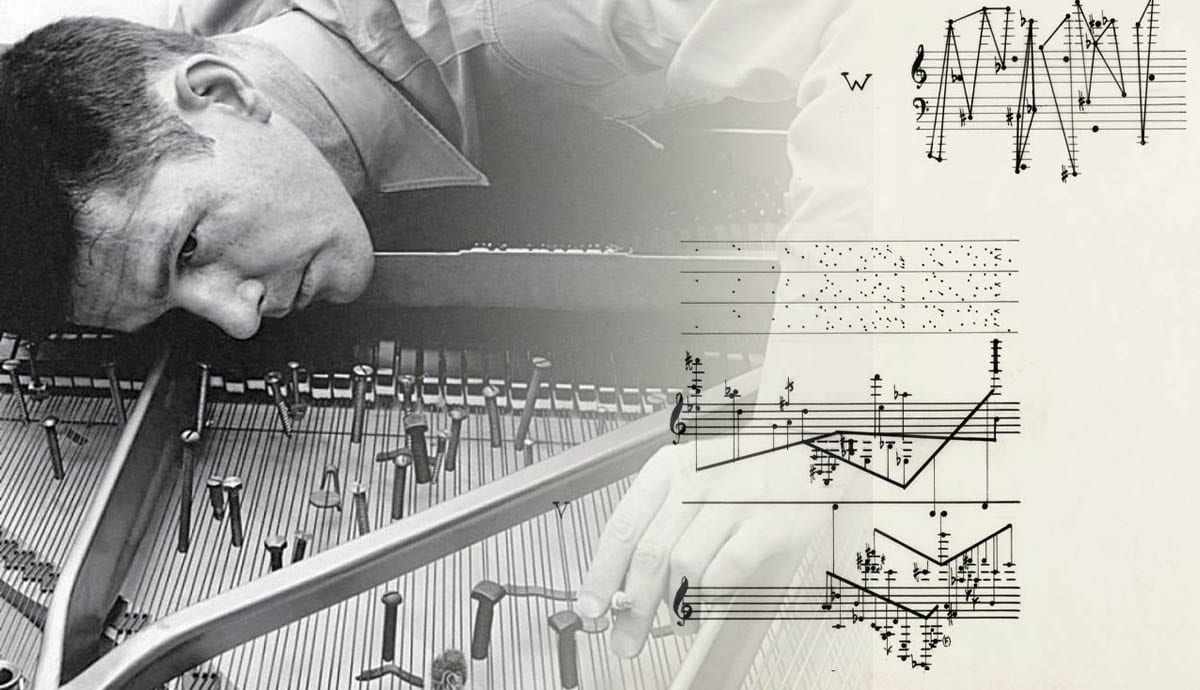
From his collaborations with the artists of the Dada and Fluxus movements to his legendary time teaching at Black Mountain College, there is little in the story of 20th-century modern art that doesn’t bear some debt to John Cage’s revolutionary mind. Of all his works, 4’33” (composed in 1952) stands out as a pivotal moment in the history of American musical and artistic performance.
John Cage’s Early Career

John Cage was born in 1912 in downtown Los Angeles. His father was an inventor, and his mother was a part-time journalist for the Los Angeles Times. He began taking piano lessons in the fourth grade, his instructors being a mix of family members and private instructors.
Cage never showed much interest in becoming the next Mozart, however, apparently showing more interest in sight-reading and composition than pure playing talent. He graduated as valedictorian of his high school intending to become a writer.
Cage became a student at Pomona College in 1928, pursuing the study of theology. He was displeased with the controlled thought taught in college courses, however, and dropped out after two years, claiming that college was no place to develop as a writer. Instead, he traveled to Europe with the financial assistance of his parents, pursuing education through life experience rather than formal schooling.
His stay in Europe would extend to some eighteen months, and span several countries, including Spain, France, and Germany. During this time, Cage studied under Lazare Lévy, a French pianist and composer. Lévy introduced Cage to the music of Bach and helped to stoke Cage’s interest in musical composition for the first time since his youth. However, it was not until Cage stayed in Majorca that he began composing his own music.
Always a Renaissance man, John Cage also maintained interests in painting, writing, and mathematics, even using mathematical equations to inform his earliest writings and compositions. However, he was dissatisfied with the results of those earliest compositions and returned to the United States in 1931.
Apprenticeship And Development

When Cage returned to the United States, he moved home to California, teaching occasional art lectures near his home in Santa Monica for money. Through his career and continued interest in the arts, Cage became acquainted with many important art figures in the southern California community. He studied composition with Richard Buhlig, a Juilliard graduate from Chicago, Illinois, and befriended multiple arts patrons. After two years, Cage had decided to shift his focus from painting and writing to focus primarily on his studies of music.
Following the advice of a peer, Cage began studying under Arnold Schoenberg, one of the leading figures of composition and German expressionism in the 20th Century. Schoenberg agreed to teach John Cage for free if Cage was willing to dedicate his life to composition (which he was). Schoenberg became Cage’s greatest inspiration for the following two years, although they were not without conflicts.
Cage eventually left Schoenberg’s tutelage following a disagreement in perspective, but Cage maintained his promise to the older composer for the rest of his life, stating some forty years later that he continued to compose not because he felt the need to write music, but because he had promised Schoenberg that he would. Schoenberg’s opinion of Cage was not one of a great composer, but of a fantastic inventor, and for that Cage earned the older man’s respect.

After leaving Schoenberg’s tutelage, Cage would move to San Francisco and then to Seattle, pursuing further studies among various colleagues and in different cultural contexts. He taught at the Chicago School of Design briefly in 1941, and a successful composition entitled The City Wears a Slouch Hat encouraged him to move to New York City to pursue more lucrative patronage, as well as further fame and recognition.
Interest In Eastern Spirituality

Upon first moving to New York City, Cage stayed at the home of Peggy Guggenheim as a sort of beneficiary of her patronage. There he became involved with many influential Dada artists such as Piet Mondrian and Marcel Duchamp, the works of whom Cage had encountered during his time in Europe. The free-spirited notions of Dada and their ant-conventions of art interested John Cage greatly, and much of the work that he created during and after the 1940s is canonically affiliated with the Dada movement. After a falling out with Peggy Guggenheim, however, Cage struggled to find positive reception for his work due to her massive influence on the New York art scene, and he again became frustrated with his musical endeavors.
In 1946, a disheartened Cage agreed to tutor a young Indian musician named Gita Sarabhai who had come to the city, in exchange for her teaching him about eastern philosophy. Sarabhai explained to Cage that the purpose of music was to sober the mind, to render one susceptible to divine influence. This broadened Cage’s understanding of composition, and he again began writing music, this time with looser structure and more room for meditative thought.
In 1951, one of Cage’s students, Christian Wolff, introduced Cage to the I-Ching, a Chinese method of divination. John Cage was deeply intrigued by the method and used the I-Ching as a means of composing entirely by chance, removing his own influence as much as possible from the musical scores. This acceptance of chance and renewed confidence in his own ability led Cage the following to finally compose a work he had been considering for years, entitled 4’33”.
Cage And 4’33”

Composed in 1952, 4’33” shattered all expectations of musical composition. Written in three movements, the work was premiered at the Maverick Concert Hall in Woodstock, New York, to be performed by acclaimed pianist David Tudor. The piece went like this: Tudor approached the piano, sat upon the bench, and closed the key lid. He and the audience then sat for some time in silence, the passage of time marked only by the subsequent opening and closing of the key lid two more times, to mark the second and third movements.
Often described as four minutes and thirty-seconds of silence, 4’33” is in fact anything but. Cage’s brilliance lies in his ability to frame silence, to hold the listener in the anticipatory moment just before a beautiful piece of music, the moment in which our ears are most attuned. In suspending the listener like this, we are led to pick up on the humming of electricity in the rafters, to the rustling of dresses in theatre seats, to the soft exhalations of our breath. The ambient sound becomes the symphony. Music is everything around us.
The impact of this work, so ahead of its time, would ripple for decades. In the Beach Boys’ album Pet Sounds, listeners are treated to the sounds of dogs barking and wind chimes singing. In Jackson Pollock’s drip paintings, he allowed his mind and body to work instinctively, without conscious influence. The Happenings movement of the 1960s expanded heavily upon framing daily experience, engaging participants to smell freshly cut grass and orange peels in a pitch-black room. John Cage was an influence upon each one of these, whether consciously or not.
John Cage’s Lasting Impact

After his controversial success with 4’33”, Cage began composing music for modern dance, working with his lifelong lover and renowned contemporary dancer, Merce Cunningham. He taught at the New School from the mid-1950s through 1961 and continued to expand his methods of using chance in his works, creating a series entitled The Ten Thousand Things. By the beginning of the 1960s, he had become a household name and had taught or indirectly influenced some of the most important working artists in America (as well as abroad) through his bold, inventive thought and practice.
One of Cage’s greatest influences was upon the Fluxus movement, a movement that emerged in light of the short-lived Happenings movement and which still exists today. John Cage taught a course entitled “Experimental Composition” during his time at the New School, from which emerged some of the largest names in early Fluxus. Allan Kaprow, George Brecht, and Dick Higgins were all students in the course. Interestingly enough, none of these students were musicians — each student emerged from distinct artistic practices, including painting, printmaking, and sculpture. Cage also worked with video artist Nam June Paik and published writings written in part by chance which influenced the world of experimental poetry from the 1960s onwards.

To this day, John Cage has arguably had more impact on art outside of musical composition. The ideas which he confronted through 4’33” and his other inventive works demanded a new means by which to consider the artist. The artist is no longer the sole creator of an object, but rather the medium through which the universe may flow. Cage died in 1992, at 79 years old. On the hundredth anniversary of Cage’s birth, curator Juraj Kojs commissioned thirteen distinct works, each four minutes and thirty-three seconds long, from composers around the globe, to honor 4’33”.
Cage brought to the forefront of composition a theory that still influences art to this day. To John Cage, all sound is music, and all happening is beautiful. The landscape of the universe performs a beautiful symphony for its creatures at each moment. Chance is its own artist, always at play around us. The genius of Cage, however, was his ability to frame it. He crafted a lens through which everyone can understand this fact in an instant — or, to be exact, in four minutes and thirty-three seconds.










